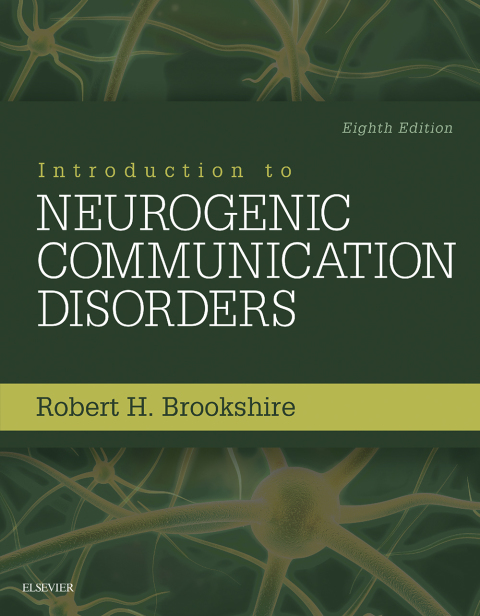Description
Efnisyfirlit
- Cover image
- Title page
- Table of Contents
- Copyright
- Dedication
- Foreword
- Preface
- Acknowledgments
- Chapter 1: Neuroanatomy of the Nervous System
- Central Nervous System
- Peripheral Nervous System
- Central Nervous System Functional Anatomy
- The Motor System
- Thought Questions
- Chapter 2: Neurologic Assessment
- The Interview and Physical Examination
- The Neurologic Examination
- Laboratory Tests
- Recording the Results of the Neurologic Examination
- Thought Questions
- Chapter 3: Assessing Adults Who Have Neurogenic Cognitive-Communicative Disorders
- The Process of Assessment and Diagnosis
- Sources of Information About the Patient
- Interviewing the Patient
- Testing the Patient
- Efficacy and Effectiveness
- Impairment, Disability, and Handicap
- Thought Questions
- Chapter 4: Assessing Cognition
- Attention
- Memory
- Executive Function
- Conclusions
- Thought Questions
- Chapter 5: Assessing Language
- Screening Tests of Language
- Comprehensive Language Tests
- Auditory Comprehension
- Reading
- Speech Production
- Written Expression
- Language Pragmatics
- Standardized Aphasia Tests
- Thought Questions
- Chapter 6: Assessing Functional Communication and Quality of Life
- Functional Communication
- Quality of Life
- Thought Questions
- Chapter 7: The Context for Treatment of Cognitive-Communicative Disorders
- The Treatment Team
- Candidacy for Treatment
- How Clinicians Decide What to Treat
- General Characteristics of Intervention
- Adjusting Treatment to the Patient
- Instructions and Feedback
- Recording and Charting Patients’ Performance
- Measuring the Effects of Treatment
- Enhancing Generalization
- Social Validation
- Conclusion
- Thought Questions
- Chapter 8: Neuropathologic and Neuroanatomic Explanations of Aphasia and Related Disorders
- Neuropathology
- Neuoranatomic Explanations of Aphasia and Related Disorders
- How the Brain Performs Language
- Patterns of Language Impairment
- Related Disorders
- Apraxia
- Agnosia
- Limitations of Connectionist Explanations of Aphasia and Related Disorders
- The Explanatory Power of Connectionist Models
- Thought Questions
- Chapter 9: Treatment of Aphasia and Related Disorders
- Process-Oriented Treatment
- Functional and Social Approaches to Intervention
- Group Treatment for Aphasic Adults
- Thought Questions
- Chapter 10: Right-Hemisphere Syndrome
- Historical Overview
- Behavioral and Cognitive Symptoms of Right-Hemisphere Brain Injury
- Communicative Impairments Associated with Right-Hemisphere Injury
- Tests for Assessing Adults with Right-Hemisphere Brain Injury
- Intervention
- Thought Questions
- Chapter 11: Traumatic Brain Injury
- Incidence and Prevalence of traumatic Brain Injuries
- Risk Factors
- Pathophysiology of traumatic Brain Injury
- Prognostic Indicators in traumatic Brain Injury
- Behavioral and cognitive Recovery
- Assessing Adults with traumatic Brain Injuries
- Intervention
- Group Treatment
- Community Integration
- Working with the Family
- Thought Questions
- Chapter 12: Dementia
- Subcortical Dementia
- Cortical Dementia
- Mixed Dementia
- Other Causes of Dementia
- Occasional Causes of Dementia
- Pseudodementia
- Delirium and Dementia
- Neurologic Conditions that May Produce Dementia-Like Signs
- Identifying Dementia
- Assessment of Persons with Dementia
- Helping People Cope with Dementia
- Management Issues
- Intervention
- Thought Questions
- Chapter 13: Motor Speech Disorders
- Apraxia of Speech
- Testing for Apraxia of Speech
- Intervention
- Dysarthria
- Evaluation
- Intervention
- Thought Questions
- Appendix A: Standard Medical Abbreviations
- Appendix B: Responses to Thought Questions
- Chapter 1
- Chapter 2
- Chapter 3
- Chapter 4
- Chapter 5
- Chapter 6
- Chapter 7
- Chapter 8
- Chapter 9
- Chapter 10
- Chapter 11
- Chapter 12
- Chapter 13
- Glossary
- Bibliography
- Index





